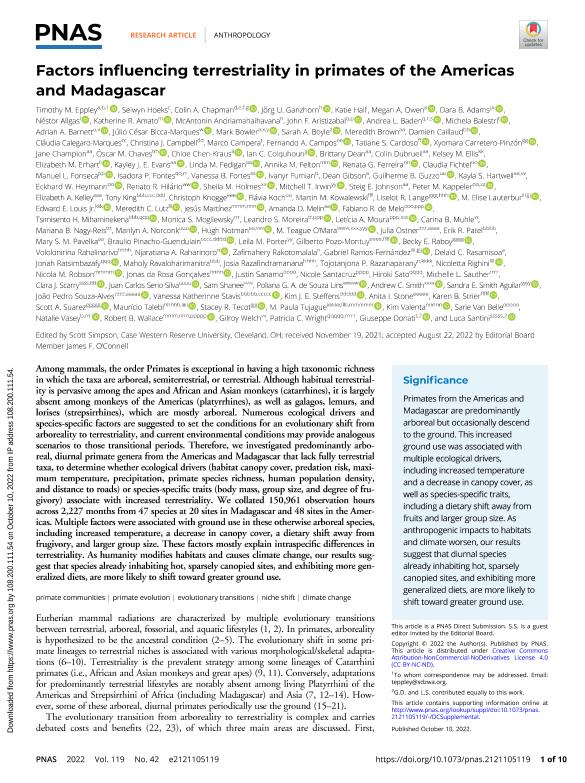Artículo
Factors influencing terrestriality in primates of the Americas and Madagascar
Eppley, Timothy M.; Hoeks, Selwyn; Chapman, Colin A.; Ganzhorn, Jörg U.; Hall, Katie; Owen, Megan A.; Adams, Dara B.; Allgas, Néstor; Amato, Katherine R.; Andriamahaihavana, McAntonin; Aristizabal, John F.; Baden, Andrea L.; Balestri, Michela; Barnett, Adrian A.; Bicca Marques, Júlio César; Bowler, Mark; Boyle, Sarah A.; Brown, Meredith; Caillaud, Damien; Calegaro Marques, Cláudia; Campbell, Christina J.; Campera, Marco; Campos, Fernando A.; Cardoso, Tatiane S.; Carretero Pinzón, Xyomara; Champion, Jane; Chaves, Óscar M.; Chen Kraus, Chloe; Colquhoun, Ian C.; Dean, Brittany; Kowalewski, Miguel Martin

Fecha de publicación:
10/2022
Editorial:
National Academy of Sciences
Revista:
Proceedings of the National Academy of Sciences of The United States of America
ISSN:
0027-8424
Idioma:
Inglés
Tipo de recurso:
Artículo publicado
Clasificación temática:
Resumen
Among mammals, the order Primates is exceptional in having a high taxonomic richness in which the taxa are arboreal, semiterrestrial, or terrestrial. Although habitual terrestriality is pervasive among the apes and African and Asian monkeys (catarrhines), it is largely absent among monkeys of the Americas (platyrrhines), as well as galagos, lemurs, and lorises (strepsirrhines), which are mostly arboreal. Numerous ecological drivers and species-specific factors are suggested to set the conditions for an evolutionary shift from arboreality to terrestriality, and current environmental conditions may provide analogous scenarios to those transitional periods. Therefore, we investigated predominantly arboreal, diurnal primate genera from the Americas and Madagascar that lack fully terrestrial taxa, to determine whether ecological drivers (habitat canopy cover, predation risk, maximum temperature, precipitation, primate species richness, human population density, and distance to roads) or species-specific traits (body mass, group size, and degree of frugivory) associate with increased terrestriality. We collated 150,961 observation hours across 2,227 months from 47 species at 20 sites in Madagascar and 48 sites in the Americas. Multiple factors were associated with ground use in these otherwise arboreal species, including increased temperature, a decrease in canopy cover, a dietary shift away from frugivory, and larger group size. These factors mostly explain intraspecific differences in terrestriality. As humanity modifies habitats and causes climate change, our results suggest that species already inhabiting hot, sparsely canopied sites, and exhibiting more generalized diets, are more likely to shift toward greater ground use.
Archivos asociados
Licencia
Identificadores
Colecciones
Articulos(CECOAL)
Articulos de CENTRO DE ECOLOGIA APLICADA DEL LITORAL (I)
Articulos de CENTRO DE ECOLOGIA APLICADA DEL LITORAL (I)
Citación
Eppley, Timothy M.; Hoeks, Selwyn; Chapman, Colin A.; Ganzhorn, Jörg U.; Hall, Katie; et al.; Factors influencing terrestriality in primates of the Americas and Madagascar; National Academy of Sciences; Proceedings of the National Academy of Sciences of The United States of America; 119; 42; 10-2022; 1-10
Compartir
Altmétricas



